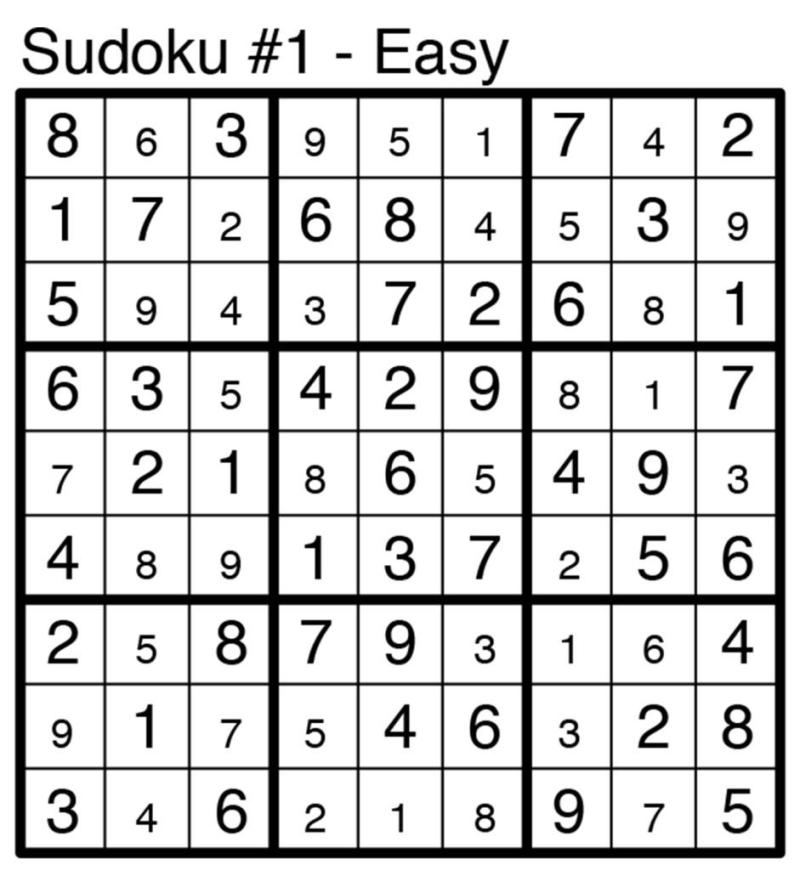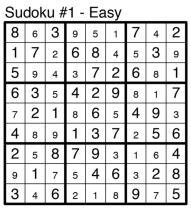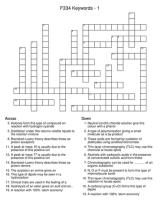How do you create a Sudoku puzzel?
Creating a Sudoku puzzle involves careful placement of numbers in a 9x9 grid following specific rules. Here's a step-by-step guide on how to create a Sudoku puzzle:
Step 1: Understand the Rules of Sudoku
- A standard Sudoku puzzle consists of a 9x9 grid divided into nine 3x3 subgrids.
- Each row, column, and 3x3 subgrid must contain the numbers 1 through 9 without repetition.
Step 2: Start with a Completed Sudoku Grid
- Begin by creating a solved Sudoku grid. This can be done manually or with the help of Sudoku-solving software.
- Ensure that the initial grid follows Sudoku rules and has a unique solution.
Step 3: Remove Numbers
- Decide on the level of difficulty for your puzzle (easy, medium, hard).
- Begin removing numbers from the completed Sudoku grid to create empty cells.
- Ensure that the puzzle remains solvable and has a unique solution.
Step 4: Maintain Symmetry
- For aesthetic purposes, it's common to maintain symmetry when removing numbers from the completed grid.
- Symmetrically removing numbers helps create a visually balanced puzzle.
Step 5: Avoid Multiple Solutions
- Be cautious not to create a puzzle with multiple solutions, as a Sudoku puzzle should have only one unique solution.
- Test the puzzle to ensure that it has a single valid solution.
Step 6: Validate the Puzzle
- Use Sudoku-solving techniques to validate the difficulty level of your puzzle.
- Ensure that it can be solved using logic and deduction, without requiring guessing.
Step 7: Test Difficulty Levels
- Test your Sudoku puzzle at different difficulty levels. You can use algorithms or human testers to evaluate the difficulty.
- Adjust the puzzle by adding or removing numbers to achieve the desired level of difficulty.
Step 8: Provide a Graded Start
- For puzzles of varying difficulty, consider providing a few starting numbers based on the puzzle's complexity.
- Starting with more given numbers makes the puzzle easier, while fewer given numbers increase difficulty.
Step 9: Create Variations
- Experiment with creating Sudoku variations, such as diagonal Sudoku, irregular Sudoku, or Sudoku-X, by introducing additional constraints or patterns.
Step 10: Finalize and Publish
- Review your Sudoku puzzle to ensure it meets quality standards.
- Finalize the puzzle and consider publishing it in print or online platforms for others to enjoy.
Remember that creating Sudoku puzzles requires practice and an understanding of the logical principles behind the game. As you gain experience, you can experiment with different patterns, variations, and difficulty levels to create unique and engaging Sudoku puzzles.
Cracking the Code: Crafting Your Own Sudoku Masterpiece
Sudoku, the brain-teasing number game, has captivated logic lovers for years. But have you ever wondered how those intricate grids come to life? Let's delve into the art of crafting your own Sudoku puzzle, from initial spark to satisfying solved state:
1. Creating a Sudoku from Scratch:
- Grid Basics: Start with a 9x9 grid divided into nine 3x3 subgrids. Each subgrid should contain digits 1-9, but never repeated.
- Seed Numbers: Place a few key numbers strategically, ensuring no row, column, or subgrid repeats the same digit. Aim for 17-20 initial numbers for a classic puzzle.
- Logic and Deduction: Use logic principles like elimination, hidden singles, and hidden pairs to fill in more numbers from your initial seeds.
- Uniqueness and Solvability: Continuously check for uniqueness (one solution) and solvability (one solution reachable through logical deduction). Backtrack if needed to maintain these critical aspects.
- Difficulty Tweaking: For harder puzzles, leave fewer seed numbers, strategically place "naked doubles" or "triples" (two or three digits appearing together in only one remaining placement), or use complex deduction techniques like X-Wing or Swordfish.
2. Strategies for Engaging and Challenging Puzzles:
- Variety is Key: Avoid repetitive patterns in seed numbers or placement. Throw in some "false leads" that require backtracking and deeper analysis.
- Aesthetic Balance: Aim for an aesthetically pleasing grid, avoiding clusters of seed numbers or obvious symmetries.
- Theme Incorporation: Consider thematic clues for advanced puzzles, like placing specific numbers in squares corresponding to letters spelling a word.
- Test and Play: Solve your own puzzle to ensure solvability and logic flow. Get feedback from fellow Sudoku enthusiasts for further refinement.
3. Software Tools and Templates:
- Sudoku Generators: Online tools like SudokuGen or Hodoku can generate basic grids with varying difficulty levels, but the creative spark and final tweaking often remain in your hands.
- Template Libraries: Websites like SudokuSolver offer pre-made templates with varying seed number placements, providing a starting point for further customization.
4. Uniqueness and Solvability:
- Backtracking and Uniqueness Checks: As you fill in squares, constantly check for potential double placements. Backtrack if needed to maintain uniqueness.
- Unique Solution Verification: Utilize software tools like Sudoku Solver's "Uniqueness Check" feature to confirm your puzzle has only one valid solution.
- Logic Flow and Consistency: Ensure all solutions rely on logical deduction rather than guesswork or trial-and-error.
5. Difficulty Levels:
- Seed Number Count: Fewer seed numbers create a harder puzzle by requiring more complex deduction techniques.
- Hidden Clues and Complexity: Introduce subtle clues like "naked doubles" or "hidden singles" for experienced players.
- Multiple Solving Paths: Offer multiple valid deduction paths to reach the solution, adding depth and replayability.
Remember, crafting a good Sudoku is a creative process. Experiment, embrace logic, and most importantly, have fun! As you hone your skills, you'll soon be sharing your own brain-teasing masterpieces with the world. Happy puzzling!











